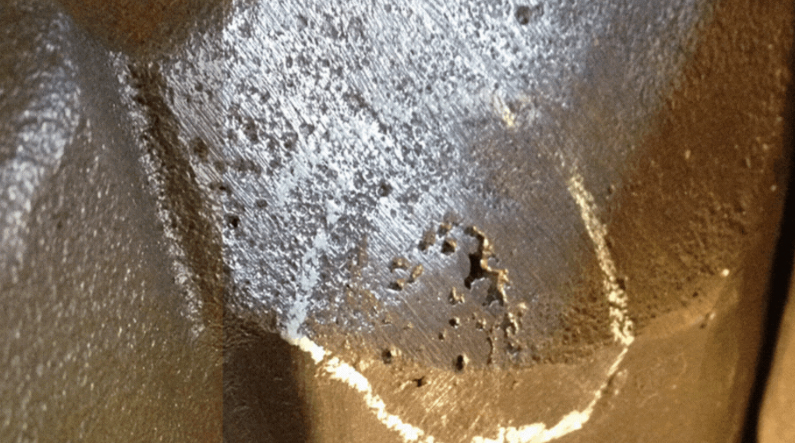Principle of Lost Foam Coating to Prevent Sand, Porosity and Sand Holes
Castings stick to sand: because the coating does not effectively isolate, or the coating reacts chemically with the high-temperature metal liquid.
(1) Poor coating adhesion: The coating peels off when the sand filling vibrates, causing sand to stick to the casting.
(2) The coating has a large expansion coefficient. When it comes into contact with the high-temperature metal liquid, the coating expands in volume due to heat, and it detaches from the casting mold, causing sand to stick to the casting.
(3) The high-temperature liquid metal is oxidized and reacts chemically with the coating and the casting mold to form metal oxides, which have extremely strong adhesion to the coating and the casting sand. It can firmly adhere the casting sand to the surface of the casting to form a series of low-melting point compounds (in the thick wall and corners of the casting, etc.), causing the casting to stick to sand. Sometimes, although no sand sticks to the casting, a layer of coating that is difficult to remove adheres to the surface of the casting.
Casting sand holes: Sand falls into the casting mold. The coating has low strength and poor refractoriness. It cannot withstand the erosion of the high-temperature metal liquid, and the casting sand is rolled into the casting.
Porosity in castings: Because there are many substances with high gas emission in the casting mold, the gas emission speed is fast, the coating or backing sand has poor air permeability, and the gas is not removed in time.
Mechanical sand sticking: The coating has high refractoriness and will not cause chemical sand sticking. But it has good air permeability. If the negative pressure is too high, the steel will penetrate the coating and cause mechanical sand sticking. It is recommended that the negative pressure be 0.03~0.04MPa. The coating layer should be brushed thinly and evenly, and the inner runner should be brushed thicker.
Carbon defects: The pouring temperature of thin parts is low, which is easy to produce wrinkles, streamlined carbon residues, etc. The general pouring temperature can be controlled at around 1550℃.
How much does the cost of lost foam coating account for the cost of castings? Every producer wants to know the answer. This is related to the price of coating. Generally, 1t of coating can make 20~100t castings, and the coating of one ton of castings is only a few dozen yuan. The larger the piece, the lower the cost, and the smaller the piece, the more coating, and the higher the cost.
Water-based composite adhesives for lost foam coatings are widely used in large, medium and small lost foam casting manufacturers. Lost foam dry powder or water-based paste lost foam coatings have the following advantages: not easy to ferment, small dosage, good suspension, high strength, low cost, 1t binder can make 12t dry powder coatings, which can be used after adding water and stirring. The coating has strong adhesion, no bubbles, and no cracking. After pouring, the coating peels off in a shell shape. The casting does not stick to sand and has a smooth surface. It can be made into more than 24t water-based paste lost foam coatings.
① Reliable quality. All product aggregates are made of high-grade clinker, which reduces burning. With high and low temperature binders, the solid coating will never crack at high temperature; different particle size grading is adopted to ensure the air permeability of the coating and prevent sand sticking.
② Cheap price. The raw materials are produced locally, and the price is much lower than that of general coating factories.
③ Process characteristics: dry powder environmentally friendly coating, which can be used after adding water and stirring, and the coating has good non-flowing property, which is particularly suitable for large-scale dip coating process. The coating is applied with enhanced adhesion, no bubbles, and no cracking. After pouring, the coating peels off in a shell shape. The casting does not stick to sand and has a smooth surface. It is suitable for the production of various cast iron parts in the lost foam process.
④The method of use is simple and easy to master: 1. Add about 70% of water according to the weight of the coating (1kg of coating plus 0.7kg of water), stir for 1h and then apply (medium speed or low stirring is best, with fewer bubbles). The amount of water added can be determined according to the brushing situation, but the amount added should not be too much. Otherwise, the coating is too thin and the coating thickness does not meet the requirements. If the amount of water added is too little, the viscosity is high, it is difficult to brush, and the coating is not easy to be uniform, and the thickness is different. According to the process conditions, it is generally brushed 2 to 3 times. Low negative pressure thick and large pieces can be brushed 3 times, and the coating thickness is more than 1mm. The amount of water added using the dip coating process is about 80%, and it should be carried out under low-speed stirring. With appropriate viscosity, the appropriate thickness (0.8-1.2mm) can be achieved by dipping 2 times.






